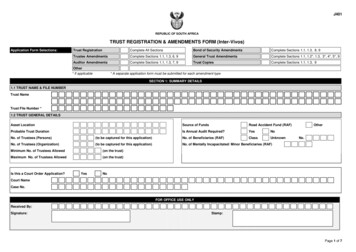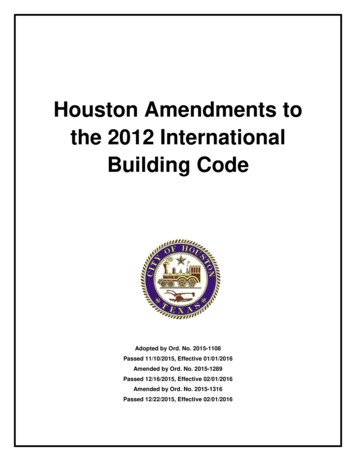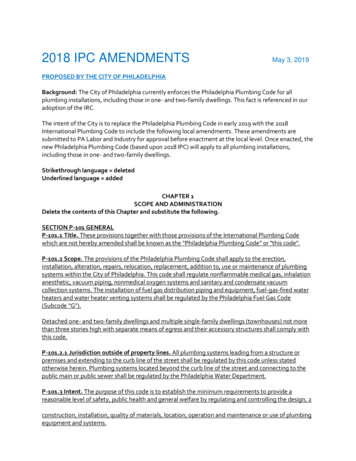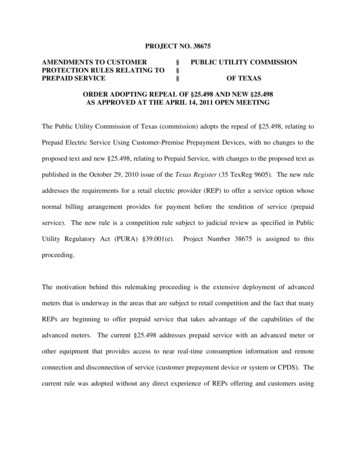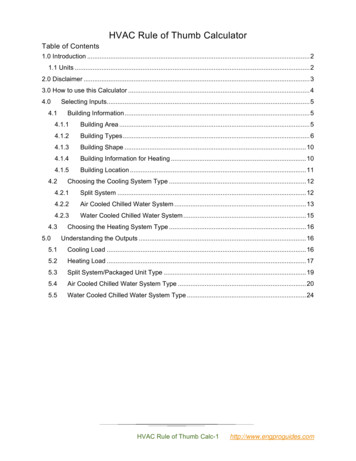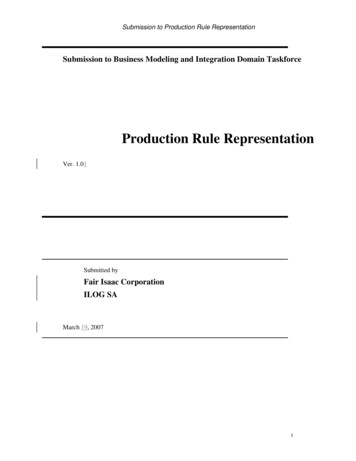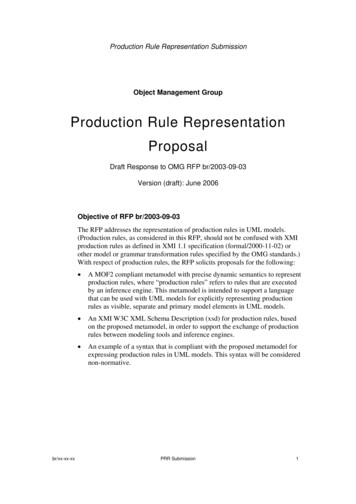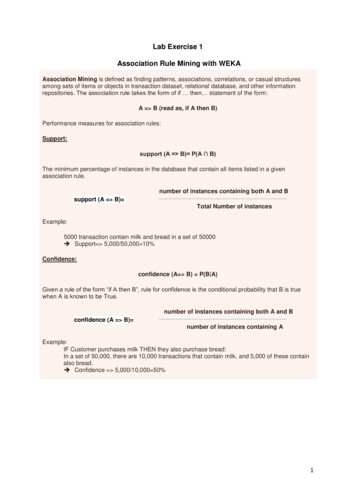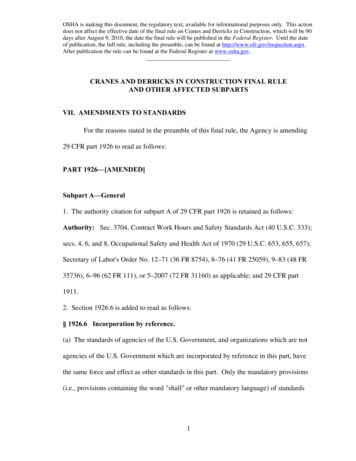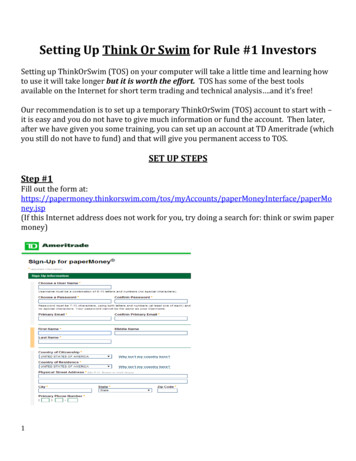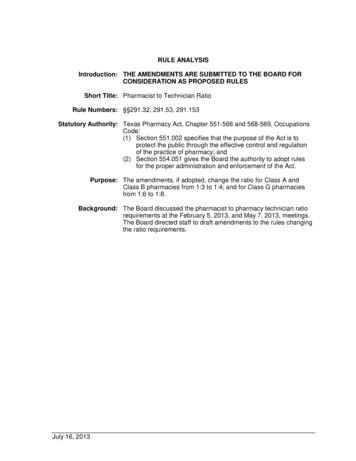
Transcription
RULE ANALYSISIntroduction: THE AMENDMENTS ARE SUBMITTED TO THE BOARD FORCONSIDERATION AS PROPOSED RULESShort Title: Pharmacist to Technician RatioRule Numbers: §§291.32, 291.53, 291.153Statutory Authority: Texas Pharmacy Act, Chapter 551-566 and 568-569, OccupationsCode:(1) Section 551.002 specifies that the purpose of the Act is toprotect the public through the effective control and regulationof the practice of pharmacy; and(2) Section 554.051 gives the Board the authority to adopt rulesfor the proper administration and enforcement of the Act.Purpose: The amendments, if adopted, change the ratio for Class A andClass B pharmacies from 1:3 to 1:4; and for Class G pharmaciesfrom 1:6 to 1:8.Background: The Board discussed the pharmacist to pharmacy technician ratiorequirements at the February 5, 2013, and May 7, 2013, meetings.The Board directed staff to draft amendments to the rules changingthe ratio requirements.July 16, 2013
03132333435363738394041424344454647484950TITLE 22 EXAMINING BOARDSPART 15 TEXAS STATE BOARD OF PHARMACYCHAPTER 291 PHARMACIESSUBCHAPTER B COMMUNITY PHARMACY (CLASS A)§291.32 Personnel(a) – (c) (No change.)(d) Pharmacy Technicians and Pharmacy Technician Trainees.(1) (No change.)(2) Duties.(A) – (B) (No change.)(C) Pharmacy technicians and pharmacy technician trainees may perform onlynonjudgmental technical duties associated with the preparation and distribution of prescriptiondrugs, as follows:(i) initiating and receiving refill authorization requests;(ii) entering prescription data into a data processing system;(iii) selecting a stock container [taking a stock bottle] from the shelf for a prescription;(iv) preparing and packaging prescription drug orders (i.e., counting tablets/capsules,measuring liquids and placing them in the prescription container);(v) affixing prescription labels and auxiliary labels to the prescription container;(vi) reconstituting medications;(vii) prepackaging and labeling prepackaged drugs;(viii) loading bulk unlabeled drugs into an automated dispensing system provided apharmacist verifies that the system is properly loaded prior to use;(ix) compounding non-sterile and sterile prescription drug orders; and(x) compounding bulk preparations.(3) Ratio of on-site pharmacist to pharmacy technicians and pharmacy technician trainees.(A) Except as provided in subparagraph (B) of this paragraph, the ratio of on-site pharmaciststo pharmacy technicians and pharmacy technician trainees may be 1:4 [1:3], provided thepharmacist is on-site and at least one of the four [three] is a pharmacy technician. The ratio ofpharmacists to pharmacy technician trainees may not exceed 1:2.July 16, 20131
51525354555657585960616263646566676869707172(B) As specified in §568.006 of the Act, a Class A pharmacy may have a ratio of on-sitepharmacists to pharmacy technicians/pharmacy technician trainees of 1:5 provided:(i) the Class A pharmacy:(I) dispenses no more than 20 different prescription drugs; and(II) does not produce sterile preparations including intravenous or intramuscular drugs onsite; and(ii) the following conditions are met:(I) at least four are pharmacy technicians and not pharmacy technician trainees; and(II) The pharmacy has written policies and procedures regarding the supervision ofpharmacy technicians and pharmacy technician trainees, including requirements that thepharmacy technicians and pharmacy technician trainees included in a 1:5 ratio may be involvedonly in one process at a time. For example, a technician/trainee who is compounding non-sterilepreparations or who is involved in the preparation of prescription drug orders may not also callphysicians for authorization of refills.(e) (No change.)July 16, 20132
0313233343536373839404142434445464748495051TITLE 22 EXAMINING BOARDSPART 15 TEXAS STATE BOARD OF PHARMACYCHAPTER 291 PHARMACIESSUBCHAPTER C NUCLEAR PHARMACY (CLASS B)§291.53 Personnel(a) Pharmacists-in-Charge.(1) General.(A) – (B) (No change.)(C) Each Class B pharmacy shall have one pharmacist-in-charge who is employed on a fulltime basis, who may be the pharmacist-in-charge for only one such pharmacy; provided,however, such pharmacist-in-charge may be the pharmacist-in-charge of:(i) more than one Class B pharmacy, if the additional Class B pharmacies are not open toprovide pharmacy services simultaneously; or(ii) during an emergency, up to two Class B pharmacies open simultaneously if thepharmacist-in-charge works at least 10 hours per week in each pharmacy for no more than aperiod of 30 consecutive days.(2) Responsibilities. The pharmacist-in-charge shall have the responsibility for, at a minimum,the following:(A) – (K) (No change)(L) legally operating [legal operation of] the pharmacy, including meeting all inspection andother requirements of all state and federal laws or rules governing the practice of pharmacy.(b) Owner. The owner of a Class B pharmacy shall have responsibility for all administrative andoperational functions of the pharmacy. The pharmacist-in-charge may advise the owner onadministrative and operational concerns. The owner shall have responsibility for, at a minimum,the following, and if the owner is not a Texas licensed pharmacist, the owner shall consult withthe pharmacist-in-charge or another Texas licensed pharmacist:(1) establishing [establishment of] policies for procurement of prescription drugs and devicesand other products dispensed from the Class B pharmacy;(2) establishing [establishment of] policies and procedures for the security of the prescriptiondepartment including the maintenance of effective controls against the theft or diversion ofprescription drugs;(3) if the pharmacy uses an automated pharmacy dispensing system, reviewing and approvingall policies and procedures for system operation, safety, security, accuracy and access, patientconfidentiality, prevention of unauthorized access, and malfunction;(4) providing the pharmacy with the necessary equipment and resources commensurate withits level and type of practice; andJuly 16, 20131
01102(5) establishing [establishment of] policies and procedures regarding maintenance, storage,and retrieval of records in a data processing system such that the system is in compliance withstate and federal requirements.(c) Authorized nuclear pharmacists.(1) General.(A) – (C) (No change.)(D) Authorized nuclear pharmacists are solely responsible for the direct supervision ofpharmacy technicians and pharmacy technician trainees and for delegating nuclear pharmacytechniques and additional duties, other than those listed in paragraph (2) of this subsection, topharmacy technicians and pharmacy technician trainees. Each authorized nuclear pharmacistshall:(i) [shall] verify the accuracy of all acts, tasks, or functions performed by pharmacytechnicians and pharmacy technician trainees; and(ii) [shall] be responsible for any delegated act performed by pharmacy technicians andpharmacy technician trainees under his or her supervision.(E) – (F) (No change.)(2) (No change.)(3) Duties. Duties which may only be performed by an authorized nuclear pharmacist are asfollows:(A) receiving verbal therapeutic prescription drug orders and reducing these orders to writing,either manually or electronically;(B) receiving verbal, diagnostic prescription drug orders in instances where patient specificityis required for patient safety (e.g., radiolabeled blood products, radiolabeled antibodies) andreducing these orders to writing, either manually or electronically;(C) interpreting and evaluating radioactive prescription drug orders;(D) selecting [selection of] drug products; and(E) performing the final check of the dispensed prescription before delivery to the patient toensure that the radioactive prescription drug order has been dispensed accurately asprescribed.(d) Pharmacy Technicians and Pharmacy Technician Trainees.(1) – (3) (No change.)(4) Ratio of authorized nuclear pharmacist to pharmacy technicians and pharmacy techniciantrainees.July 16, 20132
103104105106107108109110111(A) The ratio of authorized nuclear pharmacists to pharmacy technicians and pharmacytechnician trainees may be 1:4 [1:3], provided at least one of the four [three] is a pharmacytechnician and is trained in the handling of radioactive materials.(B) The ratio of authorized nuclear pharmacists to pharmacy technician trainees may notexceed 1:2.(e) (No change.)July 16, 20133
03132333435363738394041424344454647484950TITLE 22 EXAMINING BOARDSPART 15 TEXAS STATE BOARD OF PHARMACYCHAPTER 291 PHARMACIESSUBCHAPTER H OTHER CLASSES OF PHARMACY§291.153 Central Prescription Drug or Medication Order Processing Pharmacy (Class G)(a) – (b) (No change.)(c) Personnel.(1) – (2) (No change.)(3) Pharmacists.(A) (No change.)(B) Duties. Duties which may only be performed by a pharmacist are as follows:(i) receiving oral prescription drug or medication orders and reducing these orders to writing,either manually or electronically;(ii) interpreting prescription drug or medication orders;(iii) selecting [selection of] drug products;(iv) verifying the data entry of the prescription drug or medication order information at thetime of data entry prior to the release of the information to a Class A, Class C, or Class Epharmacy for dispensing;(v) communicating to the patient or patient's agent information about the prescription drug ordevice which in the exercise of the pharmacist's professional judgment, the pharmacist deemssignificant, as specified in §291.33(c) of this title (relating to Operational Standards);(vi) communicating to the patient or the patient's agent on his or her request informationconcerning any prescription drugs dispensed to the patient by the pharmacy;(vii) assuring that a reasonable effort is made to obtain, record, and maintain patientmedication records;(viii) interpreting patient medication records and performing drug regimen reviews; and(ix) performing a specific act of drug therapy management for a patient delegated to apharmacist by a written protocol from a physician licensed in this state in compliance with theMedical Practice Act.(4) Pharmacy Technicians and Pharmacy Technician Trainees.(A) – (B) (No change.)July 16, 20131
51525354555657585960616263(C) Ratio of on-site pharmacists to pharmacy technicians and pharmacy technician trainees.A Class G pharmacy may have a ratio of on-site pharmacists to pharmacy technicians andpharmacy technician trainees [pharmacy technicians/pharmacy technician trainees] of 1:8[1:6] provided:(i) at least seven [five] are pharmacy technicians and not pharmacy technician trainees; and(ii) the pharmacy has written policies and procedures regarding the supervision of pharmacytechnicians and pharmacy technician trainees.(5) (No change.)(d) – (e) (No change.)July 16, 20132
History of Pharmacy Technicians in TexasSummarySeptember 1, 1981 – Texas Pharmacy Act amended to recognize the persons who assist pharmacists. Theseindividuals are called “supportive personnel” and defined as: those individuals utilized in pharmacies whoseresponsibility it shall be to provide nonjudgmental technical services concerned with the preparation anddistribution of drugs under the direct supervision of and responsible to a pharmacist.November 5, 1982 – Board adopts first rules that include requirements for “supportive personnel.” Training & Qualifications:o Supportive personnel must be qualified and trained to perform the tasks assigned tothem. Duties:o Prepare Rx labels.o Initiate and receive refill authorization requests.o Prepackage drugs.September 14, 1988 – Board adopts rules to place a maximum ratio (2:1) on the number of supportivepersonnel a pharmacist is allowed to supervise in Class A pharmacies. (Note: Texas Pharmacy Act prohibitsthe Board from establishing a ratio in Class C pharmacies).March 21, 1996 – Qualifications. Rules amended to require all supportive personnel: Employed after March 1, 1996, must have a high school degree or be enrolled in a high schoolprogram. To have taken and passed the PTCB certification examination by January 1, 2001.September 1, 1997 – Texas Pharmacy Act amended to change the designation from supportive personnel topharmacy technicians and give the Board the authority to determine and issue standards for recognition andapproval of pharmacy technician training programs. The Board was also given the authority to registerpharmacy technicians, but the agency was not funded to begin this registration.September 1, 1999 – Texas Pharmacy Act amended to give the Board the authority to register pharmacytechnicians beginning January 1, 2001. (Note: No funding was provided with the passage of this bill thereforethe Board did not begin the registration of pharmacy technicians on January 1, 2001.)September 16, 1999 – The ratio of pharmacists to pharmacy technicians may be 1:3 if one of the technicians iscertified.September 1, 2003 – The Board of Pharmacy’s appropriation for the fiscal year FY2001-2003 included fundingto begin registration of Pharmacy Technicians.February 23, 2004 – Board registers first pharmacy technician.September 1, 2005 – Texas Pharmacy Act amended to give the Board the authority to register pharmacytechnician trainees.October 2006 – Board begins pharmacy technician trainee registration program.September 18, 2007 – The ratio of pharmacists to pharmacy technicians and pharmacy technician traineesmay be 1:3, provided at least one of the three is a pharmacy technician. The ratio of pharmacists to pharmacytechnician trainees may not exceed 1:2.
Gay DodsonFrom:Sent:To:Subject:Gary A Schnabel Monday, July 01, 2013 10:04 AMGay DodsonTechnician RatioHi Gay,I hope you are doing well and beating the heat. We are registering a balmy 97 degrees today. Way too hot forOregonians but we are not complaining. You all in the southwest win that right. I understand that the Texas BOP isrevisiting its technician ratio. I just wanted to drop you a note in case there is interest in what other states are doing orhave done.Oregon traditionally had a 1:1 ratio. About 10 years ago Oregon the BOP changed to a 2:1 ratio. After a couple yearswith 2:1 and no incidents the Oregon BOP engaged in a long deliberation with itself and stakeholders and ultimatelyremoved the ration altogether. The rationale was that one size does not fit all circumstances and the BOP should not bethe decider of the appropriate ratio. The PIC on site is in the best position to decide appropriate staffing. Eventually astandard of practice will evolve around tech staffing. This was not a unanimous vote.Since that time a standard of 1 to 3 technicians per pharmacist has evolved. We have only had one incident. That was acase in which a long term care pharmacy was found with seven technicians processing bubble packs for delivery, andonly one pharmacist. We simply told him he was outside the acceptable standard of practice, even for long term care,and could be in violation of our unprofessional conduct rule for practicing outside the accepted standard of practice. Theviolation is not a "ratio" violation but is "unprofessional conduct". For that to work, we had to establish that the 1-3techs to 1 pharmacist was the accepted standard. That is not to say that 3 technicians is the maximum either, but thePIC would have to defend a higher staffing pattern in terms of patient safety if there was an issue. We hardly ever hearabout or mention ratios anymore.Good luck in your deliberations. It was not an easy decision here in Oregon but it has worked out well for us. . . garyGllry A. Schnabel, RPh, RNE'l:ecutive DirectorOregon Board of Pharmacy800 NE Oregon Street, Suite 150Portland, OR 972321
Gay DodsonFrom:Hal WandTuesday, July 02, 2013 2:09 PMGay DodsonPharmacy Technician RatiosHal Wand.vcfSent:To:Subject:Attachments:Hello Director Dodson,(Gay)I heard that your board is discussing revising the pharmacist/technician ratio requirements. I thought you might want ashort summary of what AZ did several years ago.As in most states, originally AZ had a 1:1 ratio. Around 1994 we changed to a 2:1 ratio if the techs were not PTCBcertified and 3:1 if one or more were PTCB certified. A few years later, after no significant negative patient outcomesand no abuse of the process, our board met with stakeholders and determined to remove the ratio totally. The boardfelt that the permit holder and PIC were in the best position to determine the appropriate staffing levels and ratios for afacility.Our inspection staff has observed an unwritten standard of 1 to 3 technicians per pharmacist. We do limit personnel bysize of the pharmacy however, requiring either 30 or 60 square feet per additional person, regardless of whether RPh orCPhT depending on the type of pharmacy practice. Size seems to be a more appropriate limiter than number ofpersonnel and there have been no instances of huge numbers of technicians per pharmacist.The discussions should be interesting and I trust that your board will come to the best decision for Texas citizens andpractitioners.Hal WandArizona Board of PharmacyExecutive Director(602) 771-2740 Work(480) 280-3574 MobilehwandCazpharmacy.govP.O. Box 18520Phoenix, AZ 85005www.azpharmacy.gov1
-----Original Message----From: Phil BurgessSent: Monday, July 22, 2013 3:03 PMTo: Gay DodsonSubject: Follow-up on CallGay:I just wanted to follow-up on the voice mail that I left you earlier today.At the recent Illinois Board of Pharmacy meeting, the issue of the Texas Board considering revision toyour technician ratio restrictions was raised during the public forum. The Board unanimously passed aresolution to convey to the Texas Board that the Illinois Board strongly believes that the current IllinoisPharmacy regulations ( which do not have a technician ratio restriction ) are appropriate and that they inno way jeopardize the health and welfare of the citizens of the State of Illinois.This resolution will be include in our minutes .and I will pass that on to you when they are formallyapproved at the next meeting (Sept. 16th).Please call or email if you have any questions.PhilPhilip P. Burgess, RPh, DPh, MBAPrincipal, Philip Burgess Consulting, LLC3800 N. Lake Shore DriveChicago, IL 60613(773) 595-5990
1aVita lX .OURVIL L AGERECE!Vc[JPHARMACYZ0/3 JUL 25 ,.M 2: t iJuly 24, 2013TX STATE BOPH4JiMAr,vorHAND DELIVERYTexas State Board of PharmacyWilliam P. Hobby Building, Suite 3-600333 Guadalupe StreetAustin, Texas 78701RE:Pharmacist to Technician RatioDear Texas Board of Pharmacy,I am the Chief Pharmacist at DaVita Rx, the first and largest full-service pharmacycreated specifically for the unique needs of kidney patients. We have recently reached themilestone of dispensing 10 million prescriptions overall, and are proud to do so from our flagshippharmacy in Coppell, Texas. I want to thank you for researching the current ratio requirementsfor pharmacist supervision of technicians, specifically in Class A pharmacies. As we expressedin other communications, we are working with our pharmacist colleagues to advocate for andinform a decision to remove the ratio entirely. DaVita Rx understands the complexity of yourresponsibilities, and want to offer ourselves as a resource on this, or any issue before you.We believe the elimination of the ratio is critical for both growth of our pharmacy andgrowth of the pharmacy profession to allow for greater utilization of both pharmacists andpharmacy technicians. Pharmacist to technician ratios is an arbitrary model that is becomingrestrictive to some of today's changing pharmacy practice settings and models. As the pharmacywork environment is evolving away from the be a non-standard setting in pharmacy, manypharmacies offer patients more than just dispe
101 (4) Ratio of authorized nuclear pharmacist to pharmacy technicians and pharmacy technician 102 . trainees. July 16, 2013 3 103 . 104 (A) The ratio of authorized nuclear pharmacists to pharmacy technicians and pharmacy 105 technician trainees may be 1:4 [1:3], provided at lea
